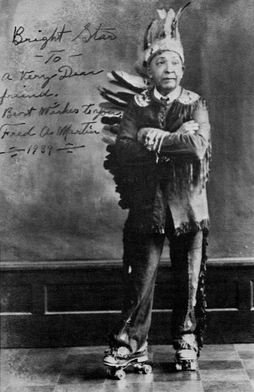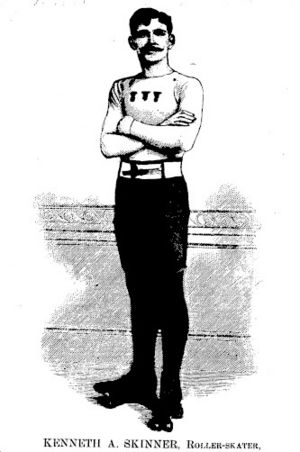Fred Murree facts for kids

Bright Star in 1939
|
|
| Personal information | |
|---|---|
| Native name | Bright Star |
| Nationality | Pawnee, American |
| Born | October 7, 1861 Pawnee territory / Nebraska Territory |
| Died | March 6, 1950 (aged 88) Philadelphia, Pennsylvania |
| Spouse(s) | Francis Alice Clews |
| Sport | |
| Sport | roller speed skating, artistic roller skating |
| Turned pro | 1879 |
| Retired | 1948 |
Fred Murree (1861–1950), also known as Bright Star, was a famous Pawnee professional roller skater. Many called him "the fastest man on wheels" during the early days of roller skating.
He was born in what is now Nebraska Territory. His family had to move east to Boston. There, Bright Star became a top roller speed skater. This was during a time when roller skating was very popular (1880–1910). Later, he also became famous for "fancy skating." This was a type of artistic roller skating where he used themes from his Native American heritage.
Contents
Early Life and Challenges
Fred Murree was born on October 7, 1861, in a Pawnee village near Omaha, Nebraska. He had two brothers and one sister. His mother passed away when he was five years old.
In the mid-1870s, the United States government made the Pawnee people move to Indian Territory (which is now Oklahoma). Instead of going there, Bright Star's father moved his family east to Massachusetts. They traveled by walking and on ponies. After three months, they reached Boston.
Murree said that when he went to public school in Boston, he often had to defend himself. Other students would attack him because of his race and his long, braided hair. After only three weeks, he left school. He then got a job at a roller rink, helping customers with their skates. While working there, he got special Plimpton roller skates with new pin bearing wheels. He then began to train as a speed skater.
Roller Skating Career
Becoming a Speed Skating Champion
Fred Murree was 17 when he entered his first race. It was a five-mile competition in Boston. Everyone expected Kenneth Skinner to win. Skinner was the fastest speed skater in Boston and held the record for five miles.
But Murree won the race! He finished in 15 minutes and 52 seconds. This beat Skinner's old record by eight seconds. Roller skating was becoming very popular in the US in the early 1880s. Skating technology was improving quickly. Some books say Murree's time in this race was a world speed record back then.
After his big win, the crowd cheered for Murree. They carried him on their shoulders and celebrated with him all night. A rink manager named Frank Clayton read about the race in the Boston newspapers. He offered Murree's father a contract. This contract meant Murree would skate for Clayton's rink until he was 21. In return, his father would get money. Murree went on to win 284 five-mile races for Clayton.
Murree later wrote that his rival, Kenneth Skinner, invented the first ball bearing skates in 1880. Skinner gave Murree the second pair ever made. These new skates helped Murree improve his record even more. According to Billboard magazine, Murree was the first person to skate 5 miles in under 15 minutes.
When Murree was 20, he tried to leave his contract with Clayton. But he returned to work when Clayton promised to pay him directly. Clayton never paid Murree's father for the contract. When Murree turned 21, the contract ended. He then began to compete in open races.
International Skating and Later Years
Around 1884, roller skating became less popular in America. Murree accepted an offer to travel to Australia for a skate manufacturer. But when he got to England, he decided to tour Europe instead. He performed in England, France, Italy, and Germany. He earned a lot of money because skating was popular there. Then he traveled to Argentina and Brazil as skating spread to South America.
After his international travels, Murree came back to the eastern United States. In 1910, he raced John Clark in Minneapolis. In 1911, he raced Fred Googins, a skating champion from Maine. He met his wife, Francis Alice Clews, at a roller rink in Boston. She was from Britain. They made their home in Red Lion, Pennsylvania.
Murree served in the First World War. He returned to skating after his military service. His racing career ended when he was injured during a race in Reading, Pennsylvania. After that, he focused on his "fancy skating" career.
Fancy Skating Performances
For his "fancy skating" shows, Murree wore Plains Indian-style clothes. He performed to both Native American music and popular songs of the time. An instructor described his act as having complex moves like four-leaf clovers, grape vines, and spirals. He also showed off his amazing balance by picking up objects with his teeth.
Murree wore a feathered headdress made by Chief White Horn. This chief was from the Omaha nation. The headdresses he made mixed traditional elements with costume-like parts.
People in the US and Europe were very interested in American Indians during Murree's career. This was partly because of movies and popular stories. Murree was offered chances to perform on the vaudeville stage. But he said no. He believed his work should stay in roller rinks to be respected. He also managed roller skating rinks in different parts of the US.
Even as Murree got older, people still wanted him to perform. His last shows were in Detroit, which was a big center for roller skating after World War II. When he was 81, Murree said he was still getting as much work as he could handle and was in good shape.
Retirement and Legacy
Fred Murree retired in 1948. He had been a professional roller skater for over 60 years. He was still getting requests to perform, but he could not do them. This was because of arthritis and his eyesight getting worse. Near the end of his career, he said, "I have enjoyed a full and useful life on skates."
Murree passed away in 1950. He was buried at Beverly National Cemetery.
Many books about roller skating, like The History of Roller Skating, say that Bright Star was the first great speed skater. He is remembered as a pioneer in the sport.
Images for kids




